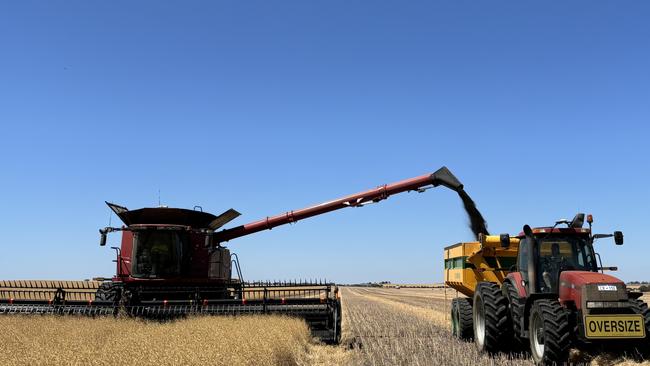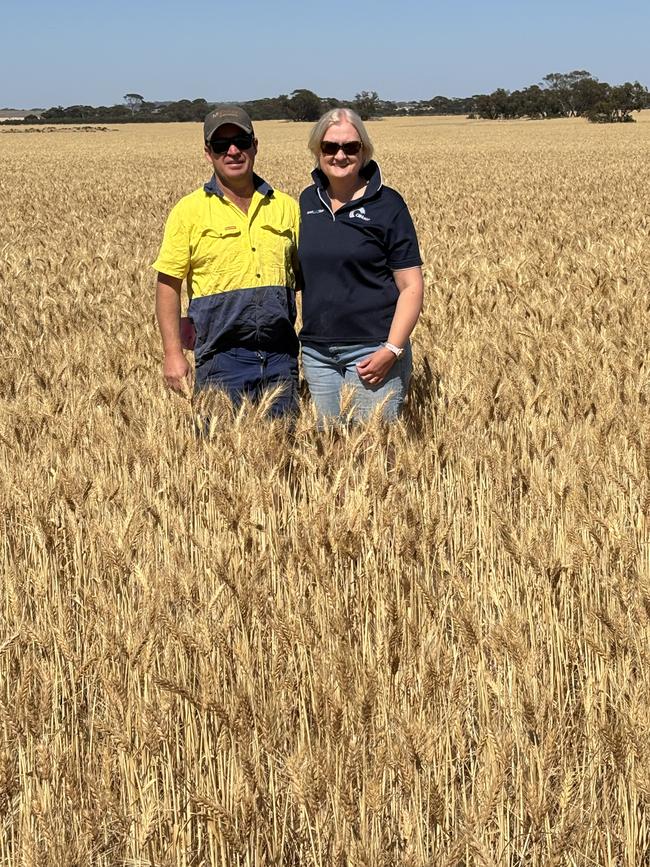How the Talbot family run their thriving WA cropping enterprise
For Bruce and his wife Heather Talbot clean crops and adaptable rotations are the hallmarks of a successful cropping operation in Western Australia.
Efficiency and the best use of labour are two critical ingredients in a successful broadacre cropping operation in Western Australia.
The aim is to complete sowing and harvesting in one pass to minimise costs and reduce overall labour.
The Talbot family runs a generational farming business at Corrigin, in Western Australia’s wheatbelt.
They prioritise mastering the fundamentals of farming and showing a strong commitment to land stewardship.
Their sheep and cropping property is located about 200km from Perth, and three generations work together to achieve collective goals. This means they do the sowing, harvest and weed management as a family and call in contractors for jobs like shearing and crutching.
Bruce and his wife Heather farm alongside Bruce’s parents Norm and Di, and the next generation, Asha, 16, and Kieran, 14, who are still both at school, lend a hand where possible.
The family has been farming in the area for 99 years and to modernise and minimise costs they share the load by adopting innovative and modern techniques such as banding chemicals and inputs in one pass. They also direct head canola rather than windrowing to save an additional pass and the need for extra equipment.

The Talbots grow winter wheat and run a self-replacing flock of 1100 Merino ewes.
Since he was a kid Bruce says his favourite time is when it is raining.
“Rain means something is going to grow,” he said.
The mix is around 65 to 70 per cent cropping and 40 per cent livestock, with a winter program consisting of canola, barley, wheat and vetch.
“At the moment, things are looking good; the dams are full, and there is a good soil moisture profile,” Bruce said.
“We are really ticking along nicely.”
Although one good rain was considered the necessary ingredient to help finish crops before harvest.
At the end of last month, they measured 280mm of rainfall for the year, and one area of the farm recorded 300mm.
The average annual rainfall for the area is around 300mm, but with changing climate and seasons, Bruce said he didn’t know what could truly be considered average anymore.
The soil consists of grey clays across the 2700ha of farming land. When it comes to productivity, overall, the business decisions and labour are assessed at each step. Plus, they go by the ethos that clean paddocks and clean crops produce good results and high yields.
If it means putting a pasture crop in the rotation for a year to minimse weeds that is the strategy that is adopted.
Despite the popularity of controlled traffic farming in their region, the Talbots have stayed with a more traditional approach that still incorporates livestock.
“We are a one-pass seeding operation and use a hydraulic tine,” he said.
Canola is grown in the rotation alongside clover and vetch are grown to provide sheep feed.
Wheat is the largest crop and equates to 60 per cent to 70 per cent of total production.
A rotation of canola, wheat, barley, and pasture is used. However, the pasture phase can be used for weed management or if there are any agronomic challenges.
Pasture also complements the livestock operation.
“I don’t keep to set guidelines with rotations,” he said.
The crops are planted using an Ausplow DBS hydraulic tine machine that has a pendulum system and is based on a 10-inch row spacing.
Bruce said this set-up was popular in Western Australia and was a heavier bar that could handle the harshness of the country.
“We usually like to start sowing by April, and we sow by the calendar rather than waiting for a seasonal break,” he said.
The program typically starts with dry seeding vetch, then canola and then some barley. By that time, they are hoping to see some rain arrive.
“I certainly wouldn’t be scared to seed or sow half of the program dry,” Bruce said.

Sowing from start to finish usually takes four to five weeks.
“We can often be halfway through the program before we see germination,” Bruce said.
Recent storms have provided a rain boost at sowing. However, it wasn’t considered typical.
“We have had 100mm arrive during seeding for the last two or three years now; it has been a bit abnormal and comes from storms,” he said.
The cropping is not without challenges, and there has been a budworm or Heliothis outbreak that has put pressure on the canola.
Inputs are applied by use of deep banding. Liquid fertiliser, and fungicide is applied about four to six inches below the soil.
“We have been using this method since 2010, and it is working for us. It is convenient,” he said.
The same ethos of efficiency is applied at harvest, and canola is stripped through direct heading, which omits the traditional windrowing phase.
Direct heading provides an alternative to windrowing and is considered cost-effective.
“We have gone to GM canola and have found we can use less machinery and don’t need another pickup front,” he said.

Barley will be harvested first this year and usually, it is a toss-up between barley or canola as to which crop comes off first.
Bruce said the barley was looking good.
“I haven’t heard of any yields yet,” he said.
Typically they look to achieve a yield of 2 tonnes/ha to 3 tonnes/ha for barley.
“Anything above 3 tonnes is good,” he said.
Canola yields of 1.2 tonnes/ha are a good benchmark, and wheat ranges from more than 2 tonnes/ha to 2.5 tonnes/ha. He was expecting the 2024 harvest to be finished before Christmas.
Meanwhile, the vetch and subclover are grazed by the sheep. However, none of the cereals or canola are grazed.
Despite a trend to go exclusively cropping, Bruce said the sheep served a purpose and added to the diversity.
“They fit the program quite well, but I think it is going to become harder to keep them,” he said.
Last year, sheep were worth $30, meaning there was little incentive for some farmers to continue running them.
Going forward, Bruce said the challenges for farming are related to input costs and the overall return on inputs.
“It is not just the inputs we use on the farm; it’s other costs like insurance,” he said.
“We got a fairly large hail storm last year ... you can’t just chuck your crop insurance out,” he said.
To drive efficiency and productivity, Bruce said his ethos is that cleaner crops are usually better crops.
None of the crops are stored on farm at harvest and the marketing is done through a broker with all deliveries to the silos at Corrigin.




